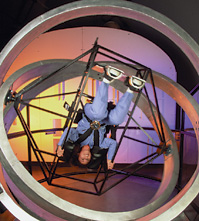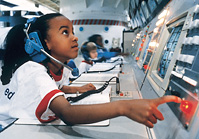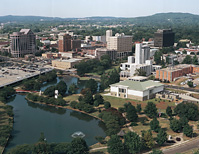DAY 1 | THURSDAY
Today your family arrives at the International Airport in Huntsville, Alabama, and transfers to the deluxe Huntsville Marriott, conveniently located on the U.S. Space & Rocket Center’s 400-plus-acre property. Take time to enjoy the hotel amenities — which include four restaurants and lounges, indoor and outdoor pools and a fitness center — before you overnight in luxury accommodations in preparation for tomorrow’s space and aviation challenges.
Huntsville Marriott
DAY 2 | FRIDAY
After breakfast this morning, your family transfers to the U.S. Space & Rocket Center® for an on-site orientation with time to pose for your own special team photo. Then, it’s on to the Aviation Challenge® hangar, where you are trained in the art of “flying” Mach 1 simulators. Practice includes simulated take-offs, landings and aerial maneuvers in these “high-powered, high-tech jets.”
You break for a well-deserved lunch, and then all members of your group resume flight training with overviews of aircraft and flight physiology. If weather permits, you may practice water survival tactics and experience a simulated pilot rescue. You are now ready for your family flight mission! Welcome to Space Challenge® . . . . Do you choose to accept your assignment?
Huntsville Marriott B L
DAY 3 | SATURDAY
Get ready! This is going to be an action-packed day at USSRC. In the morning, you train at the AREA 51 obstacle course, which has been designed to accommodate all levels of physical fitness and encourage teamwork. After lunch, you begin your family Space Challenge with orientation and simulated astronaut training on NASA-patterned simulators. These include the
1/6th Gravity Simulator,
Multi-Axis Trainer, and
5 Degrees of Freedom Chair (see
Astronaut Training Simulator Guide, below).
Your afternoon mission: repair a broken satellite. Donning astronaut suits, your family members operate from either the Space Shuttle Mission Control or on the Orbiter, positioned in the commander seats on the flight deck, the science habitat, or out in Space.
Huntsville Marriott B L
DAY 4 | SUNDAY
Astronaut training continues this morning. Family members exchange individual roles after lunch — those in Mission Control yesterday trade for “in Space” opportunities today. Then, it’s the moment of truth as your family takes on its final assignment: a launch, orbit spacewalk and landing. Communication, cooperation and your new skill sets come together as the family executes this crucial, once-in-lifetime mission challenge.
Finally, you can announce: “Mission accomplished!” A mid-afternoon graduation ceremony commemorates your family’s success in Space! Later, you transfer to the hotel, then to the airport for an evening flight home.
B
Note: The sequence of daily activities may vary. Staff will apprise you of any itinerary changes if/as they occur.
ASTRONAUT TRAINING SIMULATOR GUIDE
1/6TH GRAVITY SIMULATOR
Restrictions
Height: No restriction
Weight: 260 lbs. maximum
Designed to give trainees an idea of what it is like to walk on the Moon, this simulator is patterned after the one Apollo astronauts used for moonwalk training. The chair is called the 1/6th Gravity Chair because it simulates the Moon's gravitational pull, which is 1/6th that of the Earth's. For example, a person who weighs 120 lbs. on Earth would weigh 20 lbs. on the moon.
MULTI-AXIS TRAINER
Restrictions
Height: Head, hands and feet must reach restraints. Straps must fit tightly.
Weight: 260 lbs. maximum
The Multi-Axis Trainer simulates the disorientation one would feel in a tumble spin during reentry into the Earth's atmosphere. The MAT is patterned after the MASTIF (Multi-Axis Spin Test Inertial Facility), a series of cages within cages, used for astronaut training during NASA’s Mercury program. Astronauts used the MASTIF to condition themselves for disorientation that might occur in emergency conditions during flight.
Because the trainee's stomach stays centered, nausea shouldn't occur. Also, the MAT shouldn't spin more than twice in a row in the same direction. This prevents inner-ear fluid shifts and the dizziness that results.
5 DEGREES OF FREEDOM (5DF) SIMULATOR
Restrictions:
Height: 4 ft. (48 in.) minimum
Weight: 260 lbs. maximum
Gemini and Apollo astronauts used the 5 Degrees of Freedom Simulator to practice moving in a microgravity environment. The trainer allowed the astronauts to move in five different directions: Forward and backward, side-to-side, roll, pitch, and yaw. The sixth degree of freedom, up and down, cannot be simulated in this chair.
The 5DF runs on air bearings to simulate the frictionless environment of Space and demonstrates Newton's Third Law of Motion: For every action, there is an equal and opposite reaction.
MANNED MANEUVERING UNIT (MMU) 1-G TRAINER
Restrictions
Height: 4 ft. (48 in.) minimum
Weight: 260 lbs. maximum
The MMU 1-G Trainer simulates the MMU's controlled maneuverability in Earth orbit. In an MMU, the astronauts on a shuttle mission can travel untethered for short distances to perform satellite retrieval and repair, inspections of the orbiter surfaces, and other activities.
The MMU allows for the experience of working in space unattached to the spacecraft, which gives astronauts more freedom and mobility to perform activities in space. The MMU uses five degrees of freedom: forward and backward, side-to-side, roll, pitch, and yaw. The trainee can control these movements with joysticks.
to top



